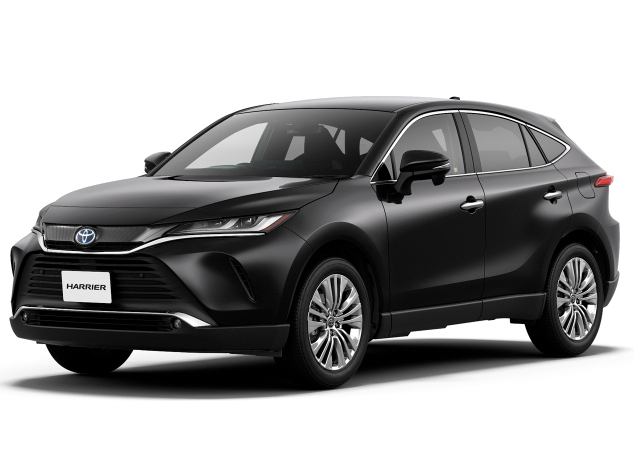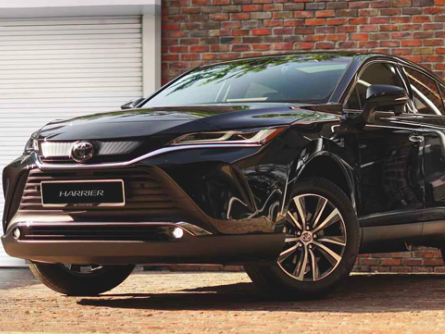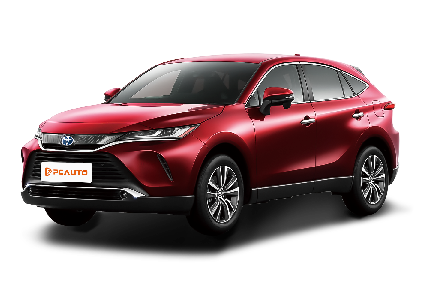Q
What is the Fuel Consumption of Toyota Harrier?
The fuel consumption performance of the Toyota Harrier varies depending on the specific model and powertrain configuration. Currently, in the Malaysian market, the 2.0-liter turbocharged gasoline engine version (model 8AR-FTS) commonly seen has a combined fuel consumption of approximately 7.5 to 8.5 liters per 100 kilometers. The hybrid version (equipped with a 2.5-liter A25A-FXS engine and the THS II system) is more fuel-efficient, with a combined fuel consumption as low as 5.0 to 5.8 liters per 100 kilometers. The actual fuel consumption will be affected by driving habits, road conditions, and the vehicle's maintenance status.
It's worth noting that hybrid models can fully leverage the advantage of electric power assistance in congested urban roads, and their fuel consumption performance is better than that of traditional fuel-powered vehicles. For Malaysian consumers, choosing the hybrid version not only helps save on fuel costs but also allows them to enjoy the government's tax incentives for energy-efficient vehicles (EEV).
It is recommended that before purchasing a car, you can refer to the latest data on the official website of Toyota Malaysia or take a test drive in person. Since 2023, some models may be equipped with the optimized Dynamic Force engine, which will further improve fuel economy. Additionally, regular maintenance such as replacing the air filter, using engine oil with the appropriate viscosity, and maintaining the correct tire pressure are all effective ways to optimize fuel consumption.
Special Disclaimer: This content is published by users and does not represent the views or position of PCauto.
Related Q&A
Q
What is the ground clearance of Harrier 2021?
The 2021 Toyota Harrier offers a ground clearance of approximately 190mm in the Malaysian market, a design that balances urban driving comfort with light off-road needs, making it suitable for the country's diverse road conditions. As a mid-size SUV, the Harrier's ride height sits between sedans and traditional off-roaders, ensuring chassis safety when tackling speed bumps or rough surfaces while maintaining a lower center of gravity for improved high-speed stability. It's worth noting that ground clearance can vary slightly based on vehicle load or optional components like sport kits, so owners should regularly check the chassis height to ensure optimal performance. Rivals in the same segment, such as the Honda CR-V or Mazda CX-5, typically have ground clearance ranging from 185mm to 210mm. The Harrier's setup leans more toward on-road driving refinement, though adding a chassis skid plate is advisable for frequent gravel road use. Malaysia's rainy climate also benefits from the higher ground clearance, enhancing water-wading capability, but drivers should note the manufacturer's specified maximum wading depth of 500mm and avoid risky attempts in deep water.
Q
What size tyres are available in Harrier 2021?
The 2021 Toyota Harrier offers different tire sizes in the Malaysian market depending on the trim level. The common spec is 225/60 R18, a size that balances comfort and road adaptability, perfectly matching the Harrier's urban SUV positioning. Some higher-end variants might come with 235/55 R19 for better handling performance. When choosing tires, always check the original factory specifications labeled inside the door jamb or fuel filler cap—it's crucial for ensuring driving safety and optimal performance. Malaysia's tropical climate means frequent rain, so prioritizing all-season tires or high-performance tires with effective rain grooves is recommended, like popular models such as Michelin Primacy 4 or Goodyear EfficientGrip. These tires deliver more stable performance on wet roads. If owners want to upgrade tire sizes, caution is advised—a diameter change exceeding 3% of the original spec could affect odometer accuracy and even cause abnormal wear to the suspension system. It's best to consult a professional tire shop and use a tire size calculator for comparison. Regularly checking tire pressure (including the spare) and tread wear is especially important for extending tire life, and for SUVs like the Harrier, monthly checks are recommended.
Q
What is the TYRE pressure for Harrier 2021?
The standard tire pressure recommendation for the 2021 Toyota Harrier is typically 230 kPa (about 33 psi) for both front and rear tires. However, the exact figures might vary slightly depending on the vehicle's trim level, tire size, or load conditions. It's best to check your owner's manual or the tire pressure label on the driver's door jamb for the most accurate info. With Malaysia's hot weather, tire pressure tends to rise a bit as temperatures go up, so just inflate to the standard value when the tires are cold—no need to adjust right after driving when they're hot. Regularly checking tire pressure not only boosts fuel efficiency and handling stability but also extends tire life. Aim to check at least once a month, and definitely before long road trips. If you often carry heavy loads or have a full car, you can bump up the rear tire pressure by 10-20 kPa to handle the extra weight, but never exceed the maximum pressure marked on the tire sidewall. Digital tire pressure gauges are more accurate than the old-school mechanical ones, and those free pressure checks at gas stations or tire shops are worth taking advantage of too.
Q
What is the acceleration of the Harrier 2021?
The 2021 Toyota Harrier in Malaysia comes with a 2.0-liter naturally aspirated petrol engine that does 0-100 km/h in around 10 seconds. The hybrid version, though, pairs a 2.5-liter engine with an electric motor to cut that time to about 8 seconds—though actual performance can vary slightly based on driving mode, road conditions, and vehicle load. For Malaysian drivers, the Harrier's acceleration is more than enough for daily city commutes and highway cruising. The hybrid model especially benefits from the electric motor's instant torque, making take-offs feel peppy. It’s worth remembering that acceleration isn’t just about engine power; transmission tuning, weight distribution, and tire grip play big roles too. The Harrier’s CVT delivers smooth power delivery, while the TNGA platform’s low center of gravity helps with stability. If you’re after more performance, we’d suggest test-driving both powertrain options. Also, keep an eye on local Malaysian automotive media for real-world test data—those reviews usually factor in how our tropical climate and local fuel quality affect the car’s performance.
Q
How much oil does a Harrier 2021 take?
The 2021 Toyota Harrier has an oil capacity of approximately 4.6 liters for the 2.0-liter naturally aspirated engine, while the 2.5-liter hybrid system requires around 5.7 liters. The exact amount should be confirmed with the owner's manual, as different engine models and whether the oil filter is replaced can affect the quantity. It's recommended to use fully synthetic oil meeting Toyota Genuine oil standards, such as 0W-20 or 5W-30. These low-viscosity oils are suitable for Malaysia's tropical climate and help improve fuel efficiency. Regular oil changes every 10,000 kilometers or 6 months are crucial for maintaining engine life, especially in Malaysia's hot and humid environment where oil tends to oxidize and deteriorate quickly. It's important to note that overfilling with oil can cause abnormal crankcase pressure and damage engine components, so after an oil change, always check the oil level with the dipstick to ensure it's between the MIN and MAX marks. If the vehicle is frequently driven in areas with poor road conditions like Sabah or Sarawak, consider shortening the maintenance interval to 8,000 kilometers and regularly check the oil condition.
Q
What is the safety rating of Harrier 2021?
The 2021 Toyota Harrier excels in safety performance, earning a 5-star rating from the ASEAN New Car Assessment Program (ASEAN NCAP). This rating is based on its comprehensive performance in adult occupant protection, child occupant protection, and safety assist technologies. The 2021 Harrier comes loaded with a range of active and passive safety features, including a pre-collision system, lane departure alert, adaptive cruise control, and seven airbags, all of which significantly enhance driving safety. For Malaysian consumers, choosing a car with a high safety rating is particularly important due to the country's complex road traffic conditions; vehicles with high safety standards can better protect drivers and passengers. Additionally, ASEAN NCAP's testing standards are strict, covering various collision scenarios and safety technology evaluations, so a 5-star rating is a strong testament to a vehicle's safety performance. Understanding a vehicle's safety rating and features not only helps consumers make more informed car-buying decisions but also reminds everyone to prioritize safety in daily driving—after all, safety is always the top consideration when traveling.
Q
What is the engine of Harrier 2021?
The 2021 Toyota Harrier offers two powertrain options in the Malaysian market: a 2.0-liter naturally aspirated four-cylinder petrol engine (codenamed 3ZR-FAE) and a 2.5-liter hybrid system (codenamed A25A-FXS). The former delivers a maximum output of 171 horsepower and a peak torque of 207 Nm, paired with a CVT transmission. The latter boasts a combined power of 218 horsepower and features an Electronically Controlled Continuously Variable Transmission (E-CVT). Both configurations cater to Malaysian consumers' dual demands for fuel efficiency and performance, with the hybrid version standing out particularly in fuel economy—perfect for the frequent stop-start nature of local road conditions. It's worth noting that Harrier's Dynamic Force engine series incorporates advanced technologies like high-speed combustion and a variable cooling system, which effectively boost thermal efficiency. The hybrid variant further comes with Toyota's proven THS II system, optimizing energy distribution via the PCU (Power Control Unit). For Malaysian users, the choice should factor in daily driving distance. If city commuting is the main use, the hybrid version significantly cuts fuel consumption, while those who often drive long distances might prefer the linear power delivery of the 2.0-liter petrol model. Additionally, Toyota's well-established local after-sales network ensures convenient maintenance for both engines, with adequate support for regular servicing and parts supply.
Q
How many types of Toyota Harriers 2023 are there?
In the Malaysian market in 2023, the Toyota Harrier is mainly available in two models: the Harrier 2.0 with a 2.0-liter naturally aspirated engine and the Harrier Hybrid 2.5 equipped with a 2.5-liter hybrid system. Both models feature front-wheel drive configuration. The Harrier 2.0 is suitable for consumers seeking a smooth driving experience, while the Harrier Hybrid attracts buyers who focus on energy-saving with its higher fuel efficiency and environmental-friendly features.
This fifth - generation Harrier is built on the TNGA-K platform. Its exterior design includes "eagle-eye" LED headlights and a through-type taillight. The interior is equipped with a 12.3 - inch touchscreen and a JBL audio system. The Toyota Safety Sense intelligent safety system comes as standard across the range, including functions such as pre-collision warning and lane-keeping assist.
It's worth noting that all Harriers in the Malaysian market are completely built-up (CBU) imports, so the prices are slightly higher than those of completely knocked - down (CKD) locally assembled cars. However, this also ensures the original factory quality. For consumers considering purchasing, it is recommended to choose the power version based on their daily driving mileage. If you often drive long distances, the hybrid version can significantly reduce fuel costs, while the 2.0 - liter version offers better cost - effectiveness for short - distance urban commuting.
Q
What is the life expectancy of a Harrier 2023?
In 2023, the normal service life of the Toyota Harrier in Malaysia can reach 15 to 20 years or cover a mileage of over 250,000 kilometers. The specific lifespan depends on maintenance conditions, driving habits, and road and environmental conditions. Regularly replacing key consumables such as engine oil, transmission fluid, and brake fluid and following the manufacturer's maintenance manual can significantly extend the vehicle's lifespan. As a mid - size SUV under the Toyota brand, the Harrier has a good reputation for its durability, thanks to its mature powertrain and reliable chassis design. The tropical climate in Malaysia has a certain impact on rubber parts and electronic components. It is recommended that car owners check the condition of suspension bushings and wiring harnesses every two years. At the same time, pay attention to anti-rust treatment of the chassis during the rainy season. For the hybrid version, special attention should be paid to the maintenance of the battery cooling system. Good driving habits, such as avoiding frequent rapid acceleration and hard braking, can also reduce mechanical wear. It's worth noting that there is a strong demand for well - maintained Harriers in the Malaysian used-car market, and they have a relatively high residual value. If you plan to use the vehicle for a long time, it is recommended to choose the original factory's extended warranty service for more comprehensive protection.
Q
Is the 2023 Toyota Harrier a 5 seater or 7 seater?
The 2023 Toyota Harrier in the Malaysian market is a 5-seater SUV, and no 7-seater version is available. This model focuses on luxury and comfort, featuring a two-row seat layout, which is suitable for family or individual users who pursue a refined driving and riding experience. As a mid-size SUV under Toyota, its body size and design emphasize rear-seat space and trunk practicality rather than a multi-seat configuration. If you need a 7-seater vehicle, you can consider other Toyota SUVs like the Fortuner or Innova. When Malaysian consumers choose an SUV, apart from the number of seats, they also need to consider the power configuration (for example, the Harrier offers 2.0L naturally aspirated and 2.5L hybrid options), fuel economy, and adaptability to local road conditions. The hybrid version of the Toyota Harrier is especially suitable for urban commuting, balancing performance and fuel consumption. Moreover, the automotive tax structure in Malaysia gives hybrid models a price advantage, which is also one of the reasons why the Harrier is popular locally.
Latest Q&A
Q
How many miles per gallon does a 2021 Mitsubishi get?
Mitsubishi's fuel efficiency in 2021 varies by model and powertrain. Take the Outlander, for example – the 2.4L four-cylinder front-wheel-drive version gets around 25 mpg combined (about 10.6 km/L). The plug-in hybrid (PHEV) model, on the other hand, delivers better efficiency in all-electric mode, though actual numbers depend on driving conditions and battery state. For Malaysian buyers, fuel economy is also affected by local road conditions, driving habits, and fuel quality. It’s best to check Mitsubishi Malaysia’s official localized data or real owner reviews for the most accurate info. With hybrids and EVs gaining traction globally, if you’re thinking about long-term running costs, keep an eye on Mitsubishi’s new energy tech – stuff like the PHEV system’s regenerative braking and all-electric range, which can really cut down on fuel use for city commutes. When picking a model, make sure to factor in your daily driving distance and how easy it is to access charging stations.
Q
What kind of engine is in the 2021 Triton GSR?
The 2021 Mitsubishi Triton GSR is powered by a 2.4-liter MIVEC turbocharged diesel engine, which features Mitsubishi's advanced common-rail direct injection technology and a variable geometry turbocharger. It cranks out 181 horsepower and a peak torque of 430 Nm, mated to a 6-speed automatic transmission, delivering strong performance and impressive fuel efficiency. It's perfectly suited for Malaysia's diverse road conditions, handling both city driving and off-road adventures with ease. This engine also meets Euro 5 emission standards, showcasing Mitsubishi's commitment to eco-friendly technology. For Malaysian consumers, the Triton GSR's engine isn't just powerful; it's also highly durable and relatively low-maintenance, making it a standout in Mitsubishi's pickup truck lineup. What's more, the turbo diesel engine provides high torque at low revs, making the vehicle particularly capable when hauling loads or towing, ideal for users who need frequent transportation or enjoy outdoor activities.
Q
What is the fuel consumption of the Mitsubishi Triton 2021?
The fuel consumption of the 2021 Mitsubishi Triton varies depending on the drive type and transmission configuration. According to official figures, models equipped with the 2.4-liter turbocharged diesel engine (with MIVEC technology) have an average fuel consumption of approximately 7.6 liters per 100 kilometers for the manual transmission version, and around 8.0 liters per 100 kilometers for the automatic transmission version. Four-wheel drive models have slightly higher fuel consumption due to additional mechanical losses, but overall, it remains one of the more fuel-efficient pickups in its class. This engine's ability to deliver high torque at low revs makes it well-suited for Malaysia's hilly terrain and cargo-carrying needs, while its ECO driving mode further optimizes fuel efficiency. It's worth noting that actual fuel consumption can be affected by driving habits, road conditions, and load. It's recommended that owners perform regular maintenance, such as cleaning the air filter and changing the oil promptly, to maintain optimal fuel efficiency. For Malaysian users who frequently drive long distances or need a vehicle that balances family and commercial use, the Triton's balanced fuel economy and reliability make it a solid choice. Other models in the same class with similar performance include the Toyota Hilux and Ford Ranger, though each has slightly different tuning priorities.
Q
How much can a 2021 Mitsubishi Triton tow?
The 2021 Mitsubishi Triton offers a maximum towing capacity of 3.1 tonnes (3100kg) in the Malaysian market. This figure applies to the automatic transmission models equipped with the 2.4-liter turbocharged diesel engine, which cranks out 181 horsepower and 430 Nm of torque—plenty of muscle to handle towing needs. It’s important to note that actual towing performance depends on factors like trailer type, load distribution, and road conditions. Owners should always consult the vehicle manual before hauling heavy loads and ensure the towing setup is properly installed.
Underpinning the Triton is a chassis built with high-strength steel and a reinforced suspension system, both working to boost towing stability. The standard trailer stability control system also helps minimize trailer sway during driving, adding an extra layer of safety. For those who tow regularly, keeping an eye on transmission oil temperature, brake system condition, and tire wear is crucial—these small checks go a long way in extending vehicle life and ensuring safe journeys. Malaysia’s hilly terrain and humid climate can affect towing performance, so it’s wise to reduce speed slightly and take more frequent breaks during long trips or when carrying heavy loads to prevent engine overheating.
Q
How big is the 2021 Triton?
The 2021 Mitsubishi Triton, a popular pickup truck in the Malaysian market, measures 5305mm in length, 1815mm in width, and 1780mm in height, with a wheelbase of 3000mm. This size ensures ample passenger space and excellent cargo capacity, with the truck bed sized at 1520mm long, 1470mm wide, and 475mm high – perfect for daily hauling and outdoor adventures. In Malaysia, it's favored for its durability and off-road performance, handling the country's varied road conditions and climate like a champ. The Triton comes with an advanced 4WD system and multiple driving modes, making light work of tricky terrains. Inside, the focus is on practicality and comfort, featuring a multifunction steering wheel and touchscreen infotainment system to up the driving experience. For Malaysian buyers, the Triton isn't just a workhorse; it's also a solid choice for family getaways. Its reliability and versatility keep it competitive in its class.
View MoreRelated News

Toyota Harrier: The Perfect Blend of Fuel Efficiency and Premium Comfort
JamesApr 23, 2025

The 2023 Toyota Harrier is priced at RM 274,000, 2.0NA+CVT
LienJul 3, 2024

Why are people more willing to choose Toyota Hilux instead of Isuzu D-Max?
JamesNov 3, 2025

In Malaysia, which sliding door MPVs are available?
MichaelOct 30, 2025

Toyota Land Cruiser FJ did not disappoint, the most anticipated civilian off-road vehicle is back.
Kevin WongOct 21, 2025
View More


















Pros
Cons